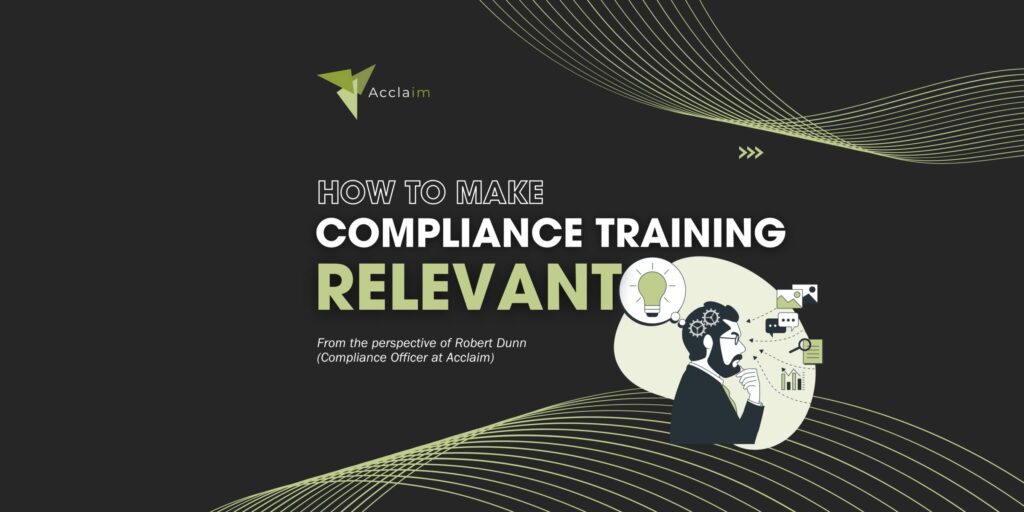
Company News
How to Make Compliance Training Relevant for All Employees
Written by Robert Dunn, Compliance Officer at Acclaim.
As a Compliance Officer, it is very easy to speak in the language that compliance professionals understand when delivering information or training relevant to compliance regulations. We speak in Compliance, and often forget that it is not everyone’s language.
As compliance training in AML/CFT, Anti-Bribery and Corruption, Risk Management, Fraud Awareness, and Data Protection is prescribed as mandatory training with annual refresher requirements, it is often not asked: “Do you understand what you just learnt?”
In the following slides, we break down how we approach training our internal team face to face.
1 – Know Your Audience!
Regular approach – Too often, a trainer will dive straight into introducing themselves and presenting the agenda of what is being covered in the training. Although the introduction of the trainer is helpful in giving the room an understanding of their background, it doesn’t tell the trainer anything about the attendees.
My approach – As the attendees enter, I display the opening screen with the title of the training session. I introduce myself at the start as the trainer, give them my background (if it is their first time with me), and explain what I hope everyone will get out of the training.
Then I ask, “What is your interpretation of [insert training subject]?” followed by:
“There is no wrong answer if it is YOUR interpretation.”
This breaks the ice before the first slide even starts. I sometimes mix it up by asking, “What are you hoping to learn from today’s session?” to focus on what they want to achieve.
2 – Speak Plain English!
Regular approach – The use of abbreviations or compliance terminology is very common in the compliance professional’s world, ranging from CRA, BRA, TRA, all the way up to RM, SAR, and STR. This often trickles down into training and is very often confusing to attendees who may not know them.
My approach – If I am going to use abbreviations, I like to provide a handout during the session (listed in alphabetical order for ease) and give a brief explanation of what each one entails. More often than not, I ask the room after explaining,
“Does everyone understand what [insert abbreviation] is? Can you explain it in your own words?”
Making it about the attendees’ understanding and asking them to explain it embeds the knowledge far better than simply stating the prescribed outcome.
“Learners retain approximately 90% of what they learn when they teach someone else immediately.”
3 – Use Relevant Examples
Regular approach – Training sessions can often be quite rigid in order to get the message across. They remain in the tone of compliance language and rarely deviate from the formal objectives. Real-world examples are usually delivered via news articles or the names of entities that received fines for breaches.
My approach – I make it relatable to the attendees by changing the explanation. One example I’ve used:
“Jurisdictions have their own rules on how things are regulated. Let’s say you’re 12 again and heading to your friend’s house for a sleepover. At your friend’s house, their parents say you don’t have to take your shoes off indoors. But at your house, your parents insist on ‘no shoes in the house’.”
Or:
“This entity got a MASSIVE fine for failing to do some basic checks or tasks. Let’s talk about what they missed and how we can help you avoid the same mistakes.”
Make it relevant by using examples they can relate to — this creates inclusion and engagement.
4 – Always Allow for Extra Time
Regular approach – This is very common in training sessions delivered online via live webinar, but also in many face-to-face sessions. The set time for training, Q&A, and closing remarks is usually fixed. One hour often means one hour — sometimes cutting the Q&A short, leaving attendees frustrated and still unclear.
My approach – If I know the training will run for 1 or 1.5 hours, I book 2 hours. This allows room for open discussion during the training on the topics presented. One person’s understanding may not be the same as another’s.
If we use the full 2 hours, great!
If we finish early, also great!
This extra time often encourages attendees to ask for clarification on certain sections, creating a clearer, more impactful learning experience.
Always make your training engaging. Use common ground with the audience. Let questions flow during the session — not just at the end. And always make it about the attendee’s experience, because they are the ones learning.
Share This Article





